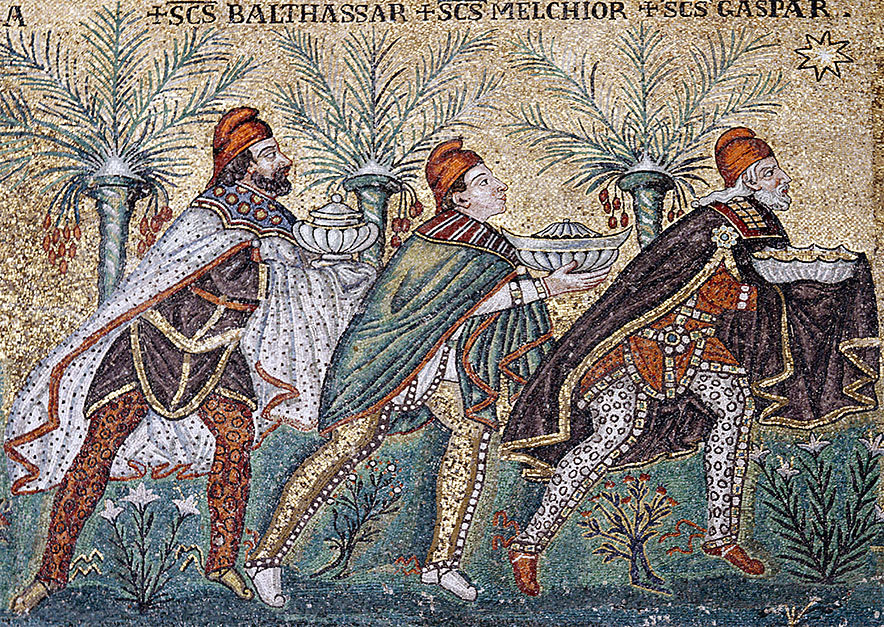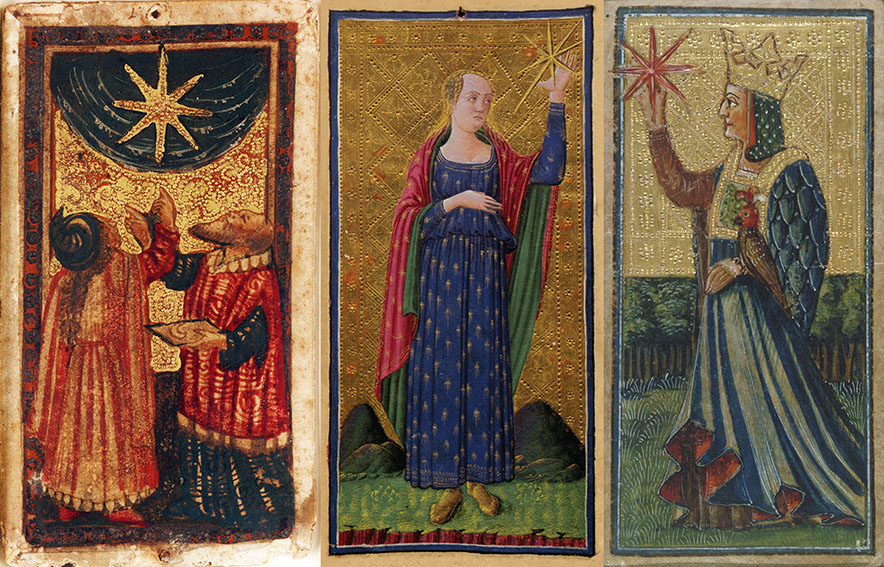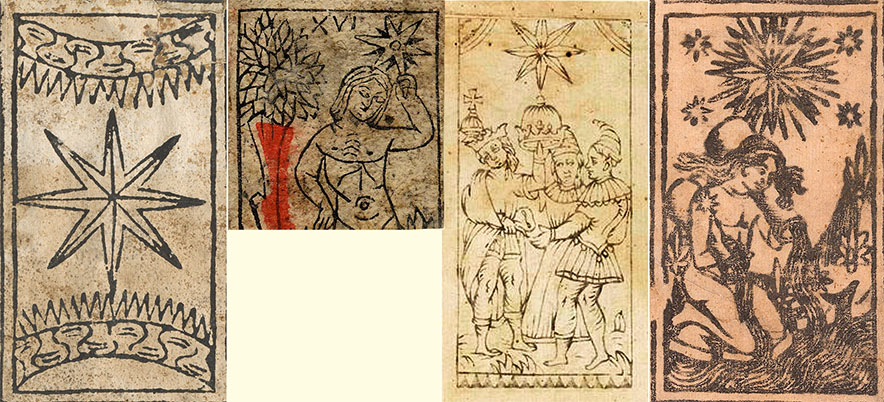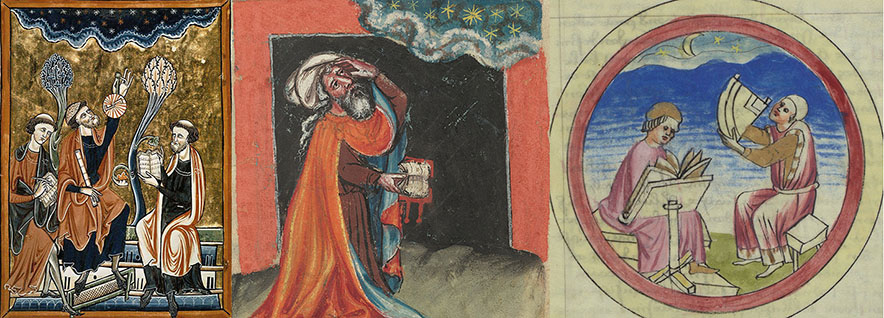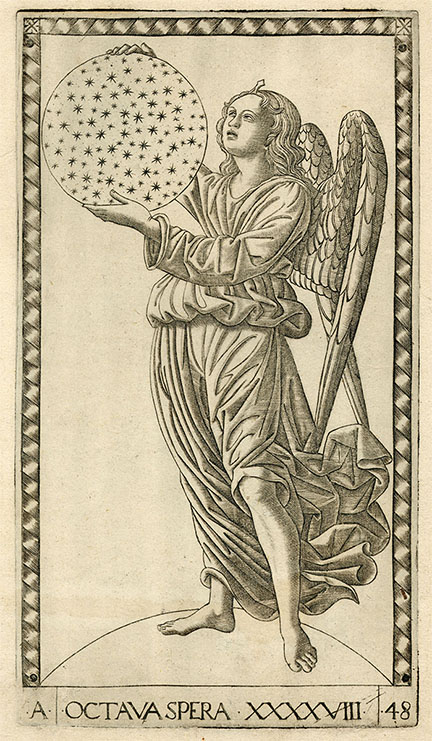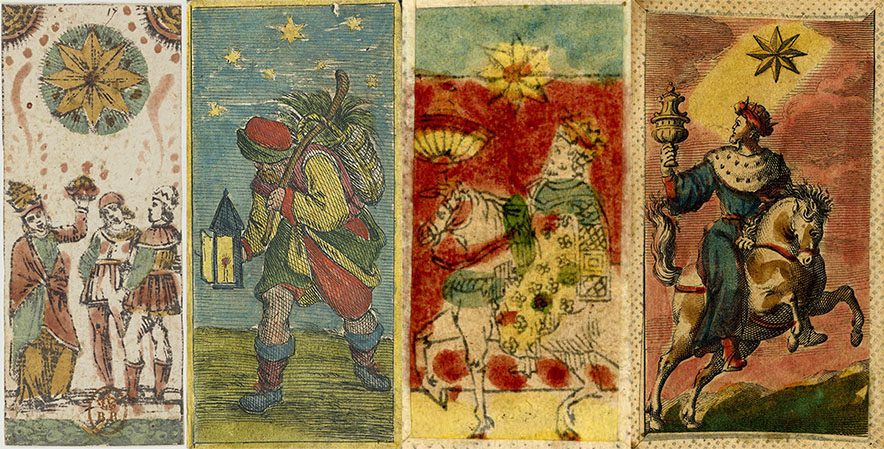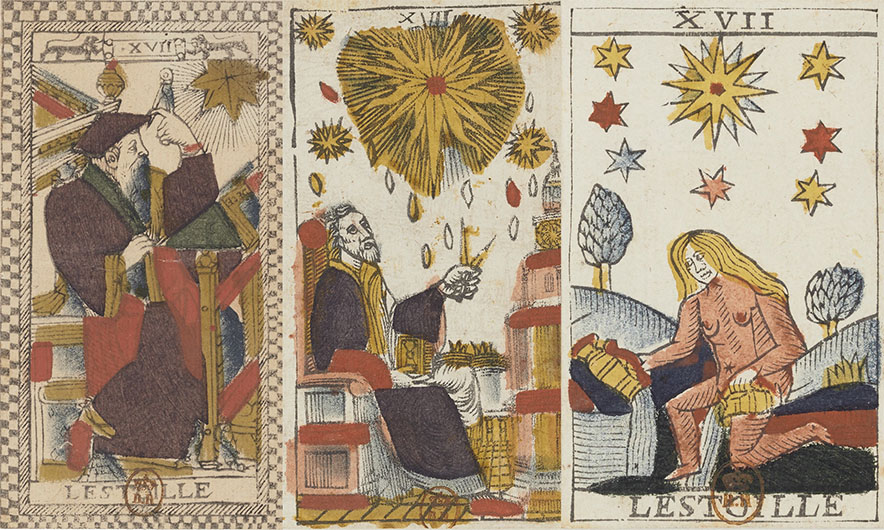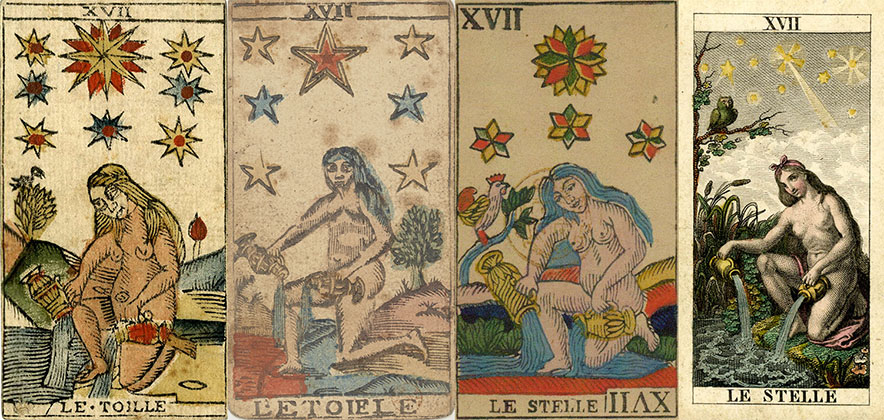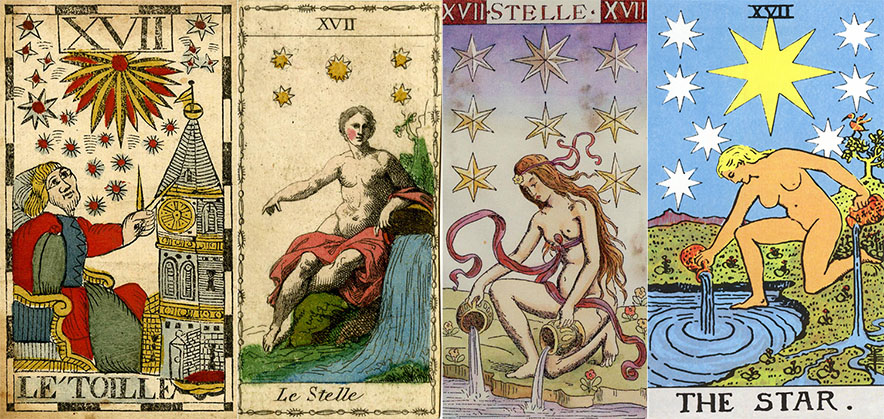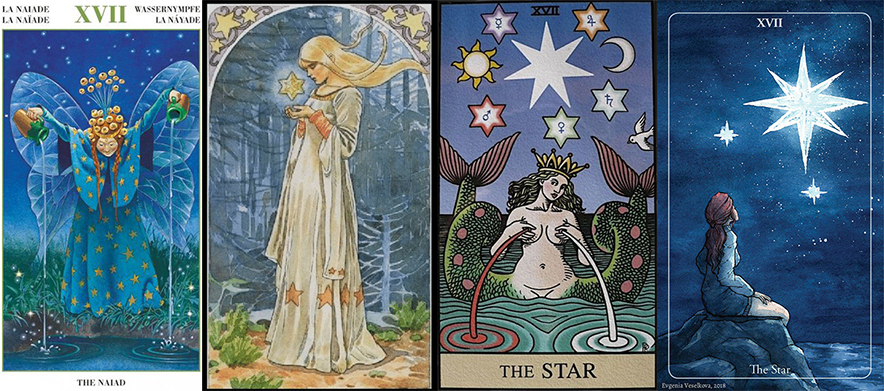THE TAROT WHEEL
LA STELLA - THE STAR
To start our journey through the history of the representation of the Star in the Tarot, we show an early sixth Century mosaic that can be found in the Basilic Sant'Apollinare Nuovo in Ravenna, Italy. It shows the three magi following the Star of Bethlehem than announces the birth of Jesus Christ. We remark that the Star of Bethlehem is represented as a star with 8 rays. The star of Bethlehem was certainly not a star. A popular explanation for the Star of Bethlehem (who appeared in the East) is the first appearance of Venus as the Morning Star. Another explanation is a conjunction of Venus, Jupiter (the king planet) and the star Regulus (the king star, brightest star in the Lion constellation) indicating as such the birth of the king of kings. Weak point about the second explanation is that this conjunction took place in 2BC, two years after Herod died, the king that the three magi visited before they arrived in Bethlehem. A third explanation is that the Christmas star was a comet. Weak point here is that no bright comets are known that appeared around the probable date of the birth of Jesus.
Whatsoever, let us first have a look at how the Star was represented on the oldest known handpainted cards.
The Star (Stella in Italian) is the first card of a group of three cards dedicated to the heavenly bodies. The other two are the Moon and the Sun, object of the next two pages. The leftmost card above is the Star from the so called Este deck, a deck realized around 1473, probably at the occasion of the marriage between Ercole I of Este, future Duke of Ferrara) and Eleanora of Aragon, daughter of Ferdinand I, the ruling king of Napels. The second card is the Star from the Visconti Sforza deck. This card did not exist in the original deck and has been added after 1475. The third Star card is from a deck of which only four cards survive. It is conserved in the Victoria and Albert Muiseum in Londen that dates the cards to 1490 and attribute it to Antonio Cicognara, who might also be the artist who created the Star card of the Viscont Sforza deck.
On the first card we see two astrologers observing a star. The star here is mostly referred to as the Star of Bethlehem. On the second card we see a giant lady, maybe Venus, placing a star in the sky. is it the Star of Bethlehem she puts on place? The third card again shows a lady placing a star in the sky with the particularity that she is crowned and has a parrot on her left arm. The Star of Bethlehem is evidently a reference to Jesus Christ who's birth brought hope back to his followers:
Blessed be the God and Father of our Lord Jesus Christ, which according to his abundant mercy hath begotten us again unto a lively hope by the resurrection of Jesus Christ from the dead,
Venus is also known as the Morning Star. As such this is equally well a reference to Jesus:
Revelation 22:16
I Jesus have sent mine angel to testify unto you these things in the churches. I am the root and the offspring of David, and the bright and morning star.
We remark that all stars on the hand painted decks have 8 rays, a common symbol for the Star of Bethlehem, that could be Venus, the Morning star. With all these references to Jesus Christ it is clear why the Star symbolizes hope after a dark period. From the above images we can deduct that the Star in the Tarot is probably the Morning star, the planet Venus.
Let us see now how the Star was represented on the printed cards from that period. In several musea there are four different uncut sheets, found in the bindings of old books during restoration works, with a card representing the Star.
All sheets date from around 1500, maybe earlier, maybe later. So the cards are not represented in chronological order. From left to right we have first the Star from the Rosenwald sheet, conserved in the Metropolitan Museum, then a partial Star card from a Budapest sheet, conserved in the Museum of Fine Arts in Budapest, next the Star card figuring on the Rothchild sheet conserved in the Louvre in Paris and at last the Star from the Cary sheet, conserved in the Cary Yale Library. All Star cards are very different. On the Rosenwald sheet we have a huge star, filling the center of the card. On the Budapest sheet a probably naked man, maybe Apollo, holding a star in his hands, like on the two handpainted decks attributed to Antonion Cocignara. On the Rothschild sheet we see three people standing under a star, two man, one crowned and holding a crown high in his hand, the other with a fool's cap on his head, and one woman in between them. On the Cary sheet we see a naked person, probably male, pouring water in a river. Here we clearly have a reference to the Zodiac sign Aquarius. Above his head a big star surrounded by four small stars. All stars have eight rays except for the star on the Budapest deck, that has only six rays. This great diversity in the star images is a hint that there doesn't exist a tradition in depicting the star in Art. And effectivily, except for the Star of Betlhehem, I have found only very few medieval and Renaissance illustrations with the Star as an important symbol. Her below some examples, first some illustrations of the Star of Bethlehem.
All three images are titled 'the adoration of the magi'. From left to right we have an illustration in a manuscript dating from the 11th Century and conserved in Salzburg, Australia. The second illustration is a mosaic made by Pietro Cavallini at the end of the 13th Century and conserved in the Basilica di Santa Maria in Trastevere in Rome, Italy. The last image is made by Giotto di Bondone in 1337 and can be seen in the Scrovegni chapel in Padua, Italy. On the two first images we see the star with 8 rays, typical for the Star of Bethlehem and on the last image the Star is depicted as a comet. We have to admit, even if the Star of Bethlehem is sometimes suggested on the Tarot cards, we never find the scene of the adoration of the magi. Let us see some other medieval images using the Star.
All three images are from medieval manuscripts. The first image is from the Psalter of Saint Louis and Blanche of Castille and dates to the 13th century. The second image shows Jonicus, the first astronomer in the World Chronicle, a drawing made about 1400–1410 by Rudolf von Ems in Regensburg, Germany. The last one is llustrated in a manuscript by Heinrich Stegmüller, created in Buchau, Germany, 1443. On all images we see astrologers observing the sky, without being sure if they are observing the stars or other objects in heaven. These images are close to the illustration on the Este Star card.
The illustration we have seen on the Cary Sheet appears in many medieval prayerbooks (books of hours) as part of the illustrations for the month of January. It represents Aquarius, one of the constellations of the Zodiac, where the Sun resides during the month of January. These illustrations are of some interest to us, because they appear on the Star card of the Tarot de Marseille (see further below). Here below some examples from different medieval prayer books.
The left most image is from the Bedford book of hours dated to 1430. All others are from French books of hours made in Paris or elsewhere in the North of France in the second half of the 15th Century. Aquarius is most of the times represented as a boy, sometimes as a woman, most of the times nude, sometimes clothed, with he or she emptying one or two jars, most of the times in a river. On one illustration the sky is filled with stars, on the other illustrations we can distinguish one or more stars or none at all. What these illustrations have in common is that stars, if any, are only there for decoration purposes, they are never the main subject.
From all illustrations shown we can conclude that the Star is never the main subject in medieval illustrations, it is an important subject in illustrations of the Star of Bethlehem, but the new born child Jesus is the main subject. The celestial bodies (including stars) figure in illustrations showing astrologers and they serve as background decoration in many prayer books, of which Aquarius has been used as an exemple.
Except for the Star of Bethlehem, why did stars have such a minor place in Medieval Art? The reason for this is probably the geocentric world model that prevailed in Medieval times. The Earth was thought to be a flat disk, surrounded by eight spheres. On the first seven spheres where placed the known moving celestial bodies, with on the first sphere the Sun and next respectively Mercurius, Venus, the Moon, Mars, Jupiter and Saturnus. On the eight and last sphere were placed the fixed stars. A representation of this eight sphere can be seen here at right on the 48th card of the so called Tarot of Mantegna (that was neither a Tarot deck, nor made by Andreas Mantegna). We see an angel holding a disk containing all the fixed stars. In the Tarot of Mantegna the other spheres are numbered from 41 (the Sun) to 47 (Saturn).
The Star in the tarot had a more inportant place than in Medieval Art. On most ancient Tarot decks the Star refers to the planet Venus, and as such indirectly to Jesus Christ ("I am the Morning Star!"). The appearance of the Star is in consequence a symbol of hope. Let us go back to the Tarot and see how the Star card developed over time. Let's continue in 17th Century Italy.
After a 15th Century with lot's of known Tarot games (even if they where not yet called as such), in the 16th Century, the game of Tarot slowly disappeared from Italy, only to persist in some regions like around Bologna and Florence. Here local variants of the Tarot game developped, like the Tarocchini games in Bologne and the Minchiate games in Florence. From left to right we see the Star card from respectively a standard Bolognese Tarocchino deck, dated to the early 17th Century, a custom made Tarocchino deck, made by Giuseppe Maria Mitelli around 1668, a 17th Century Fiorentine standard Minchiate deck (standard, because in Bologne Minchiate decks were printed using exactly the same images) and an 18th Century more elaborate Minchiate deck, also from Florence.
The composition of the standard Tarocchino deck is the same as on the Rothschild sheet with a giant star (using the same eight pointed star symbol as the Star of Bethlehem) prominently placed on the top half of the card and three people below, but in detail there are a lot of differences. On the Tarocchino card the King is replaced by an Emperor and the woman is replaced by a young man, being crowned by the Emperor. The third person, who had a fools cap on the Rothschild sheet is now wearing a crown similar to the one the Emperor is using to crown the second person. Has he also been crowned by the Emperor? The Star of Bethlehem was traditionnally interpretated as a sign that a King was born, on this card the King is being crowned. On the card made by Giuseppe Mitelli we see an image that makes us think immediately of a combination of the Hermit and the Fool, and older bearded man, holding his belongings on his back with a lantern in his hand, wandering under a starry sky. On the two Minchiate cards we see Balthasar, one of the magi following the Star of Bethlehem.
We remark the variety of the presentation of the Star, of the 12 cards presented until now on this page, there are 10 different scenes with the Star as theme. This variety in the representation of the Star, confirms clearly the absence in Medieval and Renaissance Art of representing the Star as a main theme. Let us now have a look how the Star was represented in 17th Century France.
Although the oldest Tarot decks in France were probably printed in Lyon, the oldest surviving decks are all printed in Paris. From left to right we have the anonymous Tarot of Paris, printed in the first half of the 17th Century, the Tarot of Jaques Vievil, printed probably not far before 1650 (Vievil was active starting 1645) and the Tarot of Jean Noblet, printed at least a decade later (Noblet was active starting in 1659). In fact the card of Noblet is much smaller than the other two cards, but for comparing the images all are resized to the same height. What really jumps into the eye is the similarity in the printing technique. All cards are printed on the same type of paper and all cards are using exactly the same colors. Even the back of the cards use the same hexagonal pattern. I wouldn't be amazed if these three decks were printed by the same printing workshop. On the first two cards we see a scene similar to the Este deck, with an astrologer observing a big eight pointed star in the sky, referring as such to the Star of Bethlehem. On the card of Vievil there are 8 straight rays wit eight intermittend wavy rays and 16 smaller rays. Wavy rays indicate traditionnally heat and also the drops in the sky reïnforce this idea of an excessive heat. The big star is surrounded by 4 smaller stars, identical as the star on the Cary sheet. On the card made by Jean Noblet we see a illustration in the tradition of the Aquarius illustrations, a naked woman pouring water in a stream. She has exactly the same position as the boy presented here above in the central illustration of the 5 books of hours. Above her an eight pointed star surrounded by seven smaller stars with each six rays. The Star of Jean Noblet is the first known of a long tradition of Tarot de Marseille and related cards. Here below some examples.
Four cards, all clearly inspired by the same model. The first card is the Star from the Tarot de Marseille conceived in the early 18th Century by Jean Dodal and published in Lyon. The second card is from a Besançon Tarot, graved by Pierre Isnard and published by François Laudier in Strasbourg around 1746 - 1750. The third card is an example of a Piedmontese Tarot, made around 1840 by Giovanni Guala in Ghemme Liguria. De last card is from the famous Soprafino deck, designed by Carlo Dellarocca in 1835 and published by Gumppenberg in Milano.
On the cards we see the same woman as on the Tarot of Jean Noblet, kneeling and pouring water in a river from two jars. On every card a big star surrounded by a certain number of small stars. In the Tarot de Marseille tradition there are always seven stars, but none of the clones presented here respect this number. On most cards a bird, non recognizible on the card of Jean Dodal, a cock on the Piedmontese card and an owl on the Soprafino deck. On the Piedmontese deck we remark the numbering on both the top and the bottom of the card, facilitating in this way game playing. By the 18th Century the representation of the Star card stabilizes and very few card makers propose new models. Here below some examples covering from the late 18th to the early 20th Century.
From left to right we have the late 18th Century Belgian Tarot made by Vandenborre, the early 19th Century Lombardy Tarot published by Gumppenberg in Milano, the late 19th Century Vachetta Tarot, published in a village close to Torino and the early 20th Century Rider-Waite-Smith (RWS) Tarot. The Belgian Tarot uses the Tarot of Jaques Vievil as a model, the Lombardy Tarot does not respect entirely but is clearly based on the Tarot de Marseille and both the Vachetta and the RWS Tarot respect in detail the TdM model.
With these cards we enter in the 20th Century. The RWS Tarot is right on the beginning of a whole new generation of Tarot that only respect the main structure of the Tarot (78 cards with 22 Trumps), but which allows for a great liberty in the presentation of the cards. To finish this page a random selection of Star images from modern tarot decks.
From left to right we have the 2004 Fairy tarot, made by Antonio Lupatelli, the 2009 Sorcerers tarot, realized by Antonella Castelli, the 2009 version of the Alchemical tarot, created by Robert Place and the 2018 War of the Roses tarot, designed by Evgenia Veslkova. Antonia Lupatelli renamed the Star in the Naiad, some sort of water nymph. The stars have been send to the sky background. On the Sorcerers tarot the Star became a personal object of meditation. On the Alchemical tarot the seven stars around a central star, theme of the TdM, are clearly identified as the Sun, the Moon and the 5 known planets. Water en blood, essential alchemical symbols, are poured in the river. On the War of the Roses tarot a young lady is dreaming under the light of a giant star. As on the earliest Star card, there is a great diversity in the interpretation of the Star. The Star as a small point of light in a dark sky is traditionally a symbol of hope, on the oldest Tarot cards as a personification of Jesus Christ through the symbol of the Morning Star and on modern Tarot cards expressed in a myriad of different Star images. And here ends our journey through the development of the Star symbolism since Medieval times up to modern times.
